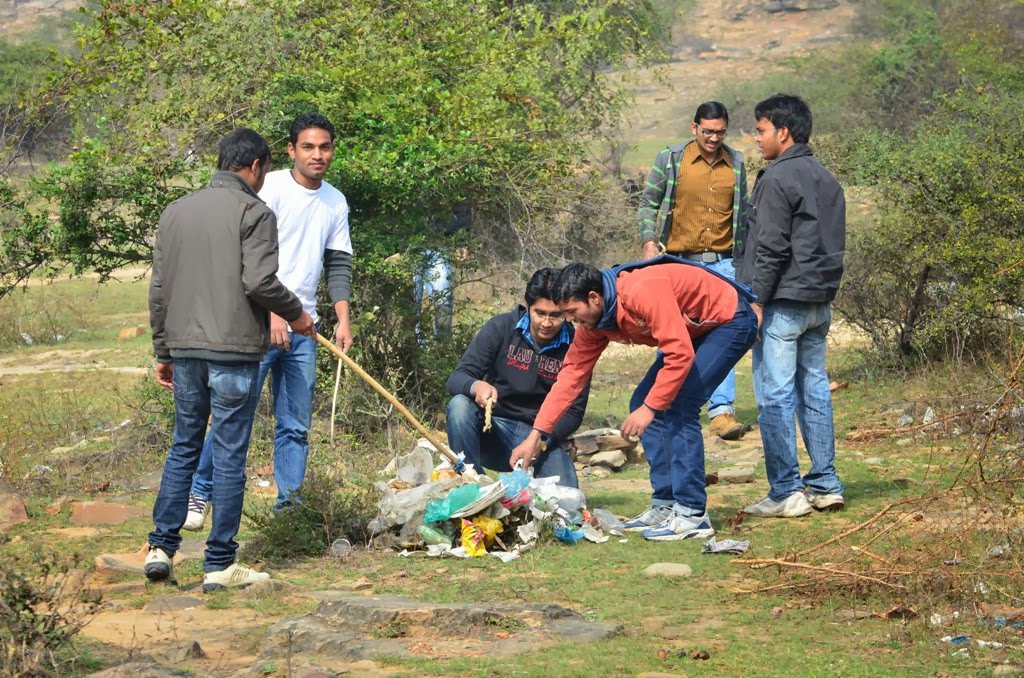पर्यावरण और सतत विकास विभाग, राजीव गांधी साउथ कैंपस, बनारस हिंदू विश्वविद्यालय में 1 फरवरी 2020 को वेटलैंड्स और जैव विविधता पर एक चर्चा सत्र आयोजित किया गया था। परिचर्चा का नेतृत्व विंध्य बचाओ के सुधांशु कुमार ने किया।
 |
| सभी प्रतिभागियों एवं आचार्यगण के साथ सामूहिक तस्वीर |
पूरी दुनिया में 2 फरवरी को विश्व आर्द्रभूमि दिवस (World Wetland Day) के रूप में मनाया जाता है । गौरतलब है कि आर्द्रभूमि दिवस का आयोजन लोगों और हमारे ग्रह के लिये आर्द्रभूमि की महत्त्वपूर्ण भूमिका के बारे में वैश्विक जागरूकता बढ़ाने के लिये किया जाता है। 2 फरवरी 1971 को विभिन्न देशों द्वारा ईरान के रामसर में दुनिया भर के वेटलैंड्स के संरक्षण हेतु एक संधि पर हस्ताक्षर किये थे, इसीलिये इस दिन विश्व वेटलैंड्स दिवस का आयोजन किया जाता है। रामसर वेटलैंड्स कन्वेंशन एक अंतर-सरकारी संधि है, जो वेटलैंड्स और उनके संसाधनों के संरक्षण और बुद्धिमतापूर्ण उपयोग के लिये राष्ट्रीय कार्य और अंतर्राष्ट्रीय सहयोग का ढाँचा उपलब्ध कराती है।
 |
| सुधांशु कुमार परिचर्चा के दौरान |
काशी हिन्दू विश्वविद्यालय के राजीव गांधी दक्षिण परिसर मे विश्व आर्द्रभूमि दिवस के अवसर पर पर्यावरण विज्ञान एवं प्रौद्योगिकी के स्नातकोत्तर प्रथम वर्ष के छात्रों के बीच मनाया गया । इस अवसर पर स्वयंसेवी संस्थान विंध्य पारिस्थितिकी एवम प्राकृतिक इतिहास संस्थान (विंध्य बचाओ) कार्यकर्ता सुधांशु कुमार छात्रों को इस वर्ष के लिए निर्धारित विषय “आर्द्रभूमि और जैव-विविधता” पर अपने विचार रखे तथा आर्द्रभूमि जैव-विविधता और उसके महत्व पर छात्रों से चर्चा किया। छात्रों को जैव-विविधता क्यों महत्वपूर्ण हैं विषय पर बने विडिओ क्लिप भी दिखाया गया। छात्रों ने निश्चय किया है की कल (2 फरवरी) को सुबह 7 बजे से परिसर मे स्थित चेकडैम (मानव निर्मित आद्रभूमि) का भ्रमण कर उसके आस पास उपलब्ध जैव-विविधता के बारे मे जानने का प्रयास करेंगे।
 |
| सभी प्रतिभागियों एवं आचार्यगण के साथ सामूहिक तस्वीर |
 |
| बाएं से- डॉ रजनी श्रीवास्तव, सुधांशु कुमार, श्री शिवकुमार उपाध्याय |
ज्ञात हो की भारत 1 फरवरी 1982 से इस संधि का हिस्सा है और इस वर्ष भारत के 10 आद्रभूमि को रामसार कन्वेन्शन द्वारा जारी अंतर्राष्ट्रीय महत्व के आद्रभूमियों की सूची मे शामिल किया गया है इसके साथ ही भारत मे अब कुल 37 अंतर्राष्ट्रीय महत्व के आद्रभूमि हो गए हैं, इन साइटों द्वारा कवर किया जाने वाला सतह क्षेत्र अब 1,067,939 हेक्टेयर है। उत्तर प्रदेश मे इसके पहले केवल एक ही आद्रभूमि इस सूची मे थी लेकिन नई सूची मे उत्तरप्रदेश के 6 (नवाबगंज, पार्वती आगरा, समन, समसपुर, सांडी और सरसईनवार) वेट्लैन्ड स्थलों को जोड़े जाने से यह संख्या अब 7 हो गई है ।
वेटलैंड्स भोजन, पानी, भूजल पुनर्भरण, जल शोधन, बाढ़ मॉडरेशन, कटाव नियंत्रण और जलवायु विनियमन जैसे महत्वपूर्ण संसाधनों और पारिस्थितिकी तंत्र सेवाओं की एक विस्तृत श्रृंखला प्रदान करते हैं। वे वास्तव में, पानी का एक प्रमुख स्रोत हैं और मीठे पानी की हमारी मुख्य आपूर्ति आर्द्रभूमि की एक सरणी से आती है जो वर्षा को सोखने और भूजल को रिचार्ज करने में मदद करती है। ये सभी आद्रभूमी प्रवासी पक्षियों को अस्थयी आवास के रूप में बहुत ही पसंद आता है।
 |
| डॉ विजय कृष्ण छात्रों मुखातिब - परिचर्चा के दौरान |
इस अवसर पर पर्यावरण विज्ञान एवं प्रौद्योगिकी के स्नातकोत्तर विषय के शिक्षक श्री अनिल कुमार पाण्डेय, डॉ रजनी श्रीवास्तव एवं श्री विजय कृष्ण अपने विचार रखे । विंध्य बचाओ के सह संस्थापक श्री शिवकुमार उपाध्याय (वरिष्ठ पत्रकार) भी छात्रों से मिल कर उनसे अपने विचार साझा किए ।
 |
| छात्रों द्वारा बनाया गया पोस्टर |

























+by+Eco+One+(11).JPG)

